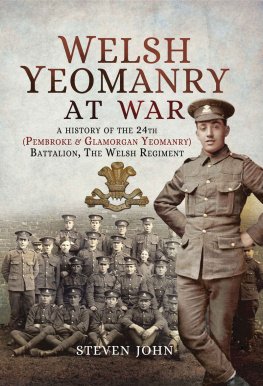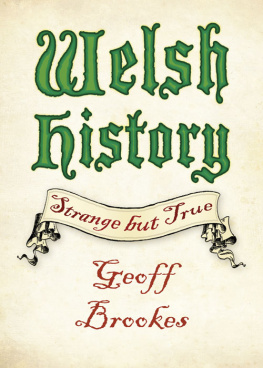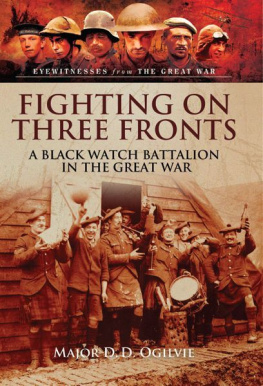Welsh at War
THROUGH MUD TO VICTORY: THIRD YPRES AND THE 1918 OFFENSIVES
Steven John

First published in Great Britain in 2018 by
PEN & SWORD MILITARY
an imprint of
Pen and Sword Books Ltd
47 Church Street
Barnsley
South Yorkshire S70 2AS
Copyright Steven John, 2018
ISBN 978 1 52670 035 3
eISBN 978 1 52670 037 7
Mobi ISBN 978 1 52670 036 0
The right of Steven John to be identified as the author of this work has been asserted by him in accordance with the Copyright, Designs and Patents Act 1988.
A CIP record for this book is available from the British Library.
All rights reserved. No part of this book may be reproduced or transmitted in any form or by any means, electronic or mechanical including photocopying, recording or by any information storage and retrieval system, without permission from the Publisher in writing.
Pen & Sword Books Ltd incorporates the imprints of
Pen & Sword Archaeology, Atlas, Aviation, Battleground, Discovery, Family
History, History, Maritime, Military, Naval, Politics, Railways, Select, Social
History, Transport, True Crime, Claymore Press, Frontline Books, Leo Cooper,
Praetorian Press, Remember When, Seaforth Publishing and Wharncliffe.
For a complete list of Pen and Sword titles please contact
Pen and Sword Books Limited
47 Church Street, Barnsley, South Yorkshire, S70 2AS, England
E-mail:
Website: www.pen-and-sword.co.uk
Contents
Acknowledgements
M uch of the material within these pages comes from a wide-ranging variety of sources, while details of the casualties themselves come from over a decade of research by the author into Welsh casualties and award-winners. The author is grateful for all the help he has received while carrying out his research into war memorials in west Wales over the past twelve years but is especially grateful to all at Pen & Sword Books, especially Roni Wilkinson, for showing continued support in publishing my work and to Nigel Cave for having the patience to proofread and correct my last two works; to Pamela Covey for editing this latest series; to John Dart, former curator of the now closed Welsh Regiment Museum at Cardiff for allowing the author to copy several of their excellent photographs; to Les Nixon, of Clynderwen, for his assistance and advice over the last ten years; and also to Bob Pike who, over the last decade, has supplied the author with countless photographs of war graves in France, Italy, Gallipoli and Israel.
The author did originally start out with the intention of writing a chapter on touring battlefield sites that are of interest to anyone following the Welsh troops during the war but, as work on the book continued, it became obvious that there were too many stories to try to fit into the confines of this book and that almost every part of every battlefield of the Great War was visited by Welsh troops at one time or another.
It is therefore recommended that anyone fostering the idea of visiting the battlefields, especially those of France and Belgium, which the author knows well, should gain confidence in the fact that if he can make the trip in his usual disorganized manner then anyone can, but that good maps and guide books, particularly the ones written by Major and Mrs Holt and the more specialized books in the fantastic Battleground Europe series, all of which are available from Pen & Sword, are invaluable and packed with interesting facts. These books also contain tips on travelling, places to stay and must-see places to visit that may otherwise be missed. A list of publications particularly recommended for battlefield touring, from the authors own personal experience, can be found below in the Bibliography section.
While the CWGC publishes a very useful pocket-sized book with maps of France and Belgium overlaid with locations of cemeteries and memorials, it should also be noted that for anyone with a Sat-Nav a free download is available from http://www.poigraves.uk that contains the locations of almost every war grave in Britain, Belgium and France and makes life for the battlefield tourist so much easier. The download is also available through the Tom Tom updater itself. This excellent resource has proved to be a massive time-saver for the author on his last few trips to France and is highly recommended in preventing domestic disputes!
Introduction
B y the end of July 1917 preparations for the forthcoming Third Battle of Ypres, or Passchendaele, had been finalized and the main assaulting troops were in position. The Welsh troops, who had taken part in heavy fighting on the Somme and at Arras over the preceding twelve months, had suffered terrible losses and were now reinforced by fresh conscripts.
Welsh troops had performed well, especially at Mametz Wood and at Delville Wood during the Somme offensives where some ground had been gained from the Germans; the Battle of Arras had been largely a failure as the Germans had withdrawn to the strongly-defended Hindenburg Line, which had proved to be almost unbreakable.
Passchendaele would see another attempt by Sir Douglas Haigs troops to break the stalemate, but they would become bogged down as the wet Flanders winter drew in. However, a further assault later in the year, to the south, against the Hindenburg Line at Cambrai, would give the allies fresh hope that 1918 may see victory come to pass.
On 6 April 1917 the Americans declared war on Germany and begun to draft tens of thousands of men into their armed forces. The United States navy was the first to respond, sending a battleship group to Scapa Flow to join the Royal Navy, while by the spring of 1918 American soldiers who had begun landing in France were beginning to take up positions in the front line.
The early months of 1918 would, sadly, see the disbandment of some Welsh battalions but the surplus men were, in the main, posted to other Welsh units as reinforcements.
Unanticipated by both sides, 1918 would turn out to be the most deadly year of the entire war. The Germans would attempt three separate offensives that would fatally deplete their strength, and the addition of the Americans to the allied cause would swing the tide of war in favour of the allies by the summer.
The campaigns in Mesopotamia, Palestine, Salonika and Italy were also finally brought to a close during this year.
Welsh troops played a part in all the coming battles and would play an especially large part in the final actions of the war, cumulatively known as the Hundred Days Offensive.
This final book of three volumes of the Welsh at War tells of the role played by Welsh troops throughout this final period of the conflict, from the part played by the 38th (Welsh) Division during the opening day of the Passchendaele offensive through to the role played by Welsh units during the Hundred Days Offensive, in the hope that Welsh people will once again remember the glorious part played by our ancestors during some of the other periods of the war, not just at Mametz Wood and Pilckem Ridge.











